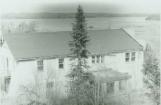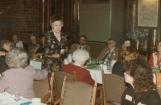1
“Oh, you poor thing. I can’t believe your husband made you come up to this dreadful place. What on earth are you going to do there? Couldn’t he get a nice, safe job down here?”These are the pitied phrases that many women hear when they decide to move to northern communities like Red Lake, usually at the request of their husbands. And these comments are usually from family or friends in larger southern cities like Toronto or Ottawa.
Many have not experienced the breathtaking landscapes and the serene nature that surround these northern areas and are only familiar with what they see on television or have read in books, what they think of as barren wasteland with no opportunity whatsoever for nice, young women.
2
This was the perception that Margaret McDougall was determined to change. Both her and her husband, Kenneth, grew up in well-to-do families in Ottawa, but headed north in the mid '20s to McDougallville, located 19 miles east of Sioux Lookout, with some of his family.The McDougalls owned a mill there. The employees of the mill were the only ones who really lived there; it was just off the CNR railway.
3
Margaret McDougall, a prominent member of the Red Lake Community1986
Red Lake, Northwestern Ontario, Canada

4
Margaret was educated, having entered St. Hilda’s (Trinity) College at The University of Toronto in 1915. She earned a BA in linguistics while she was there. She also studied business after University and landed a job as mail secretary and book purchaser at Carnegie (now Ottawa Public) Library.Margaret was also talented as an organist, being noted in the University annual as having “great dramatic and musical ability.” She was a great lover of art, culture and drama, everything that city life could provide her.
But she found northern life a great adventure and seized the appealing opportunity.
5
The couple married on April 14, 1925. Things were rough starting out.The sawmill went bankrupt, so the couple moved to Hudson in 1927 where Kenneth opened a transportation company. By then they had two daughters (a son came to be three years later), but his company, again, went broke.
So Kenneth opened a trading post in Red Lake and Margaret, along with daughters, joined him in October, 1932.
7
Kenneth started by selling merchandise from a scow because he was refused a shop downtown. There was already one shop owned by Joe Kert and he had the monopoly. As far as anyone was concerned, he owned Red Lake, and it was difficult to convince people to shop at their store.Finally, Kenneth bought a little log cabin - the ground level was the store and the upper level was their home. They didn’t get much business from downtown. Since those people shopped at Joe Kert’s, much of their business came from miners and pilots.
For some time the McDougalls were considered quite unpopular by the town folk, but Margaret was undaunted. “I didn’t come here for my social status, I came here to make a living like everyone else,” she once said.
An avid bridge player, Margaret and the wives of miners formed their own bridge club, The Upstarts, even though those women were pressured not to socialize with Margaret.
9
Life seemed to be progressing for the McDougalls, but Margaret’s family in Ottawa still pitied her. They couldn’t understand why she wanted to live in such a place. She urged her parents to come up and visit one summer. There was so much for them to see.They lived in a nice apartment in Ottawa and while her father was much more open-minded, Margaret says her mother couldn’t stand life up here. “She figured if you didn’t live in Ottawa or Toronto, you might as well be dead.”
Kenneth dealt a lot with furs in his trade and her mother would ask why Margaret didn’t have a mink coat. “What do I want with a mink coat,” Margaret would reply. “I don’t have anywhere to wear it.”
Even after the McDougalls had been living in Red Lake for 20 years, her mother would still say, “You’re not going to live up here all your life, are you?”
Her cousin’s wife Doris shared the same view. They lived in a large house in Cleveland and Kenneth and Margaret would visit them often.
“He would never get anybody else to go live up there with him,” Doris would say. “Now that’s just silly,” Margaret said. “Gold mines aren’t brought into production by a bunch of dummies. What about the dam they built up here?”
If there was one thing that Margaret couldn’t stand, it was being felt sorry for by friends and family. “I hated being pitied. She (Doris) always pitied me; thought I’d lost out.”
11
Even though her family couldn’t see it, Margaret knew there was much more to gain in a small, northern community.Her presence was certainly apparent in the community: she was one of the original members of the Anglican Women’s Association, she was a member of the founding committee of the Red Cross Hospital, she was the first librarian in Red Lake’s public library, she officially opened both the Pioneer Club and the Museum, she founded Red Lake’s first Art Club which persuaded Group of Seven painter A.Y. Jackson to sketch here, and she began writing "Red Lake Report" for The District News in her 50s.
Her dedication to the church was recognized with a plaque presentation in 1977 followed by a bishop naming her “The First Lady of Red Lake,” and her work in the community was honoured in 1984 with the Ontario Bicentennial Medal and in 1990 she received The Ontario Senior Achievement Award.


